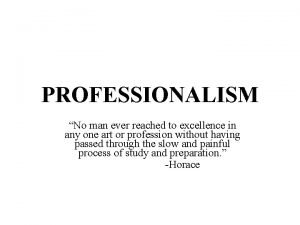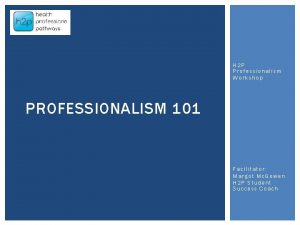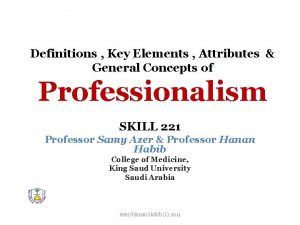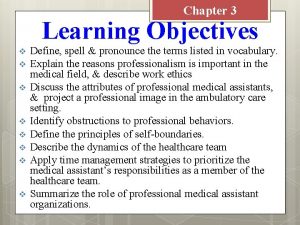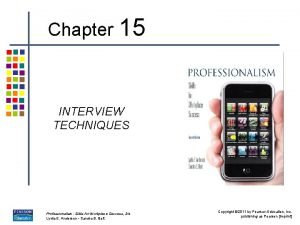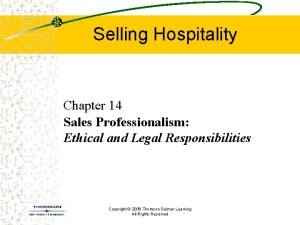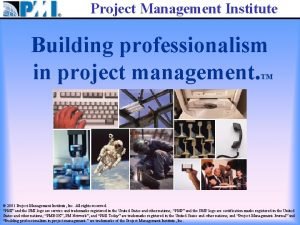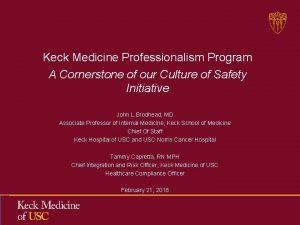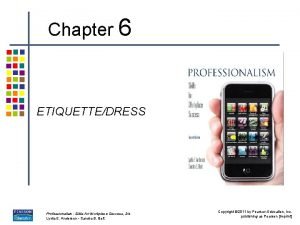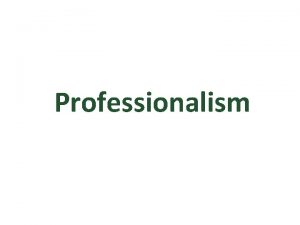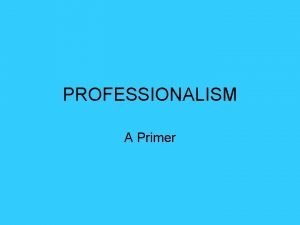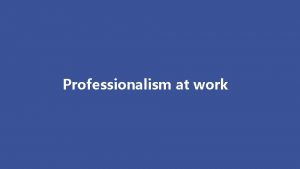The Importance of Professionalism Unit 1 Professionalism The


















- Slides: 18

The Importance of Professionalism Unit 1

Professionalism The competence or skill expected of a professional How we look How we dress How we talk How we write How we interact with others The single biggest thing you will ever sell is yourself!

Characteristics of a True Professional

Attitude Builds Character “I can get the job done no matter what. ” Do you see the glass as half empty, or half full? Professionals see it as half full We all have likes and dislikes The workplace is like your classes You like some things more than others You have to do the things you HAVE to do in order to do the things you WANT to do

Soft Skills in the Workplace Soft skills is a term associated with: A person’s reasoning ability can be measured by their Emotional Intelligence Quotient (EQ) • • • A person’s EQ Social attibutes Communication Language Personal habits Interpersonal skills Management of people Leadership Any other traits that characterize relationships with other people

Soft Skills Employers Look For

Three Types of Communication Verbal Communication “It’s not what you said, it’s how you said it. ” Saying the wrong thing can cost your job, and can even have legal consequences Nonverbal Communication Body language Cues give off while listening to someone else Nonverbal communication tips: Nod your head to acknowledge you are listening Make eye contact with the person speaking to you Show an open body (keep shoulders back and arms uncrossed)

Written Communication The expansion of communication technology in our workplace has placed a strong emphasis on written communication skills. Tweets, emails, blogs, live chats – your writing skills are being read and reviewed by readers. Nothing spoils a document faster than at typo or a grammatical error. Know your audience Format business document properly Focus on content and style Proofread thoroughly and revise accordingly Be concise – less is more

Goals, Deadlines, & Schedules • Businesses operate in a similar fashion to your school schedule • Structure • Deadlines • Organization • Schedules

Teamwork and Collaboration The cooperative or coordinated effort on the part of a group of persons acting together as a team or in the interests of a common cause A team player is a person who works well as a member of a team or a group

T i m e M n a t n a g


Rules & Regulations in the Workplace Company Policies and Procedures Set by companies and are established to: Comply with all federal, state, and local regulations and laws Keep employees safe Reflect the company’s mission statement and overall identity Maintain the reputation and credibility of the company



Unwritten Rules and Workplace Ethics Respecting co-workers’ workspace and privacy Not taking credit for others’ ideas Being courteous Listening to others without interrupting Putting away cell phones during meetings

How Government Regulates the Workplace Regulatory Agencies Department of Labor – oversees wages and hour, employer obligations, employee rights, and occupational safety. Occupational Safety and Health Administration (OSHA) – part of the Department of Labor, they enforce standards for workers, but also provides workplace safety training and education. Equal Employment Opportunity Commission (EEOC) – enforces federal laws prohibiting employment discrimination: Unfair treatment for any reason Harassment Denial of reason workplace accommodations Retaliation

 Unit 6 review questions
Unit 6 review questions No professionalism
No professionalism Domain 4 examples
Domain 4 examples Discuss principles of professionalism
Discuss principles of professionalism Professionalism workshop
Professionalism workshop What are the 3 key elements of professionalism?
What are the 3 key elements of professionalism? Self boundaries for medical assistants
Self boundaries for medical assistants Professionalism skills for workplace success
Professionalism skills for workplace success Attributes of professionalism
Attributes of professionalism What is professionalism
What is professionalism Sales professionalism
Sales professionalism What is professionalism
What is professionalism Professionalism in project management
Professionalism in project management Professionalism conclusion
Professionalism conclusion Professionalism conclusion
Professionalism conclusion Gracious professionalism definition
Gracious professionalism definition Vanderbilt professionalism program
Vanderbilt professionalism program Ac 61-65
Ac 61-65 Professionalism: skills for workplace success
Professionalism: skills for workplace success

